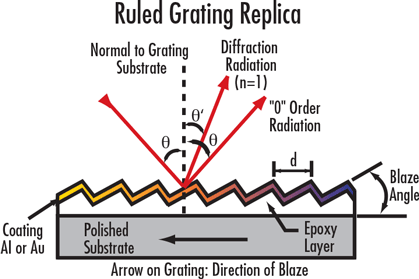
Reflective Ruled Diffraction Gratings are optical components that separate (diffract) white (polychromatic) light into its component wavelengths. Theoretical resolving power is directly proportional to the number of grooves per millimeter ruled into the master grating. The blaze angle and groove spacing determine the specific wavelength and spectral region where the grating has its maximum efficiency. Reflective Ruled Diffraction Gratings are high quality, instrument-grade gratings that are ideal when high efficiency is the primary concern in devices such as monochromators and spectrometers. Each grating is fabricated from a highly accurate master grating that is copied many times. The duplication process is described below for replicated gratings.
Diffraction ruled gratings are used in a variety of monochromators for research, student and industry use. Almost all commercially available spectrophotometers (ultraviolet, visible, infrared, fluorescence, Raman, atomic absorption) utilize diffraction gratings to select specific wavelengths or scan over a wavelength interval. Generally, replicated ruled gratings should be used when high peak efficiency and throughput is required. Replicated holographic gratings should be used when minimum stray light is critical and high resolution is needed. Note: Damage thresholds for both ruled and holographic gratings are 350 milli-joules/cm2 for pulsed lasers and 40 Watts/cm2 for CW lasers.
Handling Gratings: Gratings require special handling, making them prone to fingerprints and aerosols. Gratings should only be handled by the edges. Before attempting to clean a grating, please contact us.
Ruled diffraction gratings are produced by ruling a series of closely spaced, straight parallel grooves into an optically flat aluminum coated substrate, known as the “master grating.” Precise, interferometrically-controlled ruling engines utilize a very fine diamond tool to form a sawtooth-shaped groove profile at a given angle (commonly referred to as the blaze angle) on the surface of a prepared substrate. The replication process begins with the surface contour of a ruled master grating being vacuum deposition-coated with an extremely thin separation layer. An aluminum coating is then deposited on top of this separation layer. Then, an epoxy-coated flat glass substrate is placed on top of the layer-covered master, duplicating the grooved surface. The combination is cured and the process is finished when the replicated grating is separated from the master grating.

or view regional numbers
QUOTE TOOL
enter stock numbers to begin
Copyright 2023, Edmund Optics Inc., 101 East Gloucester Pike, Barrington, NJ 08007-1380 USA
California Consumer Privacy Acts (CCPA): Do Not Sell or Share My Personal Information
California Transparency in Supply Chains Act